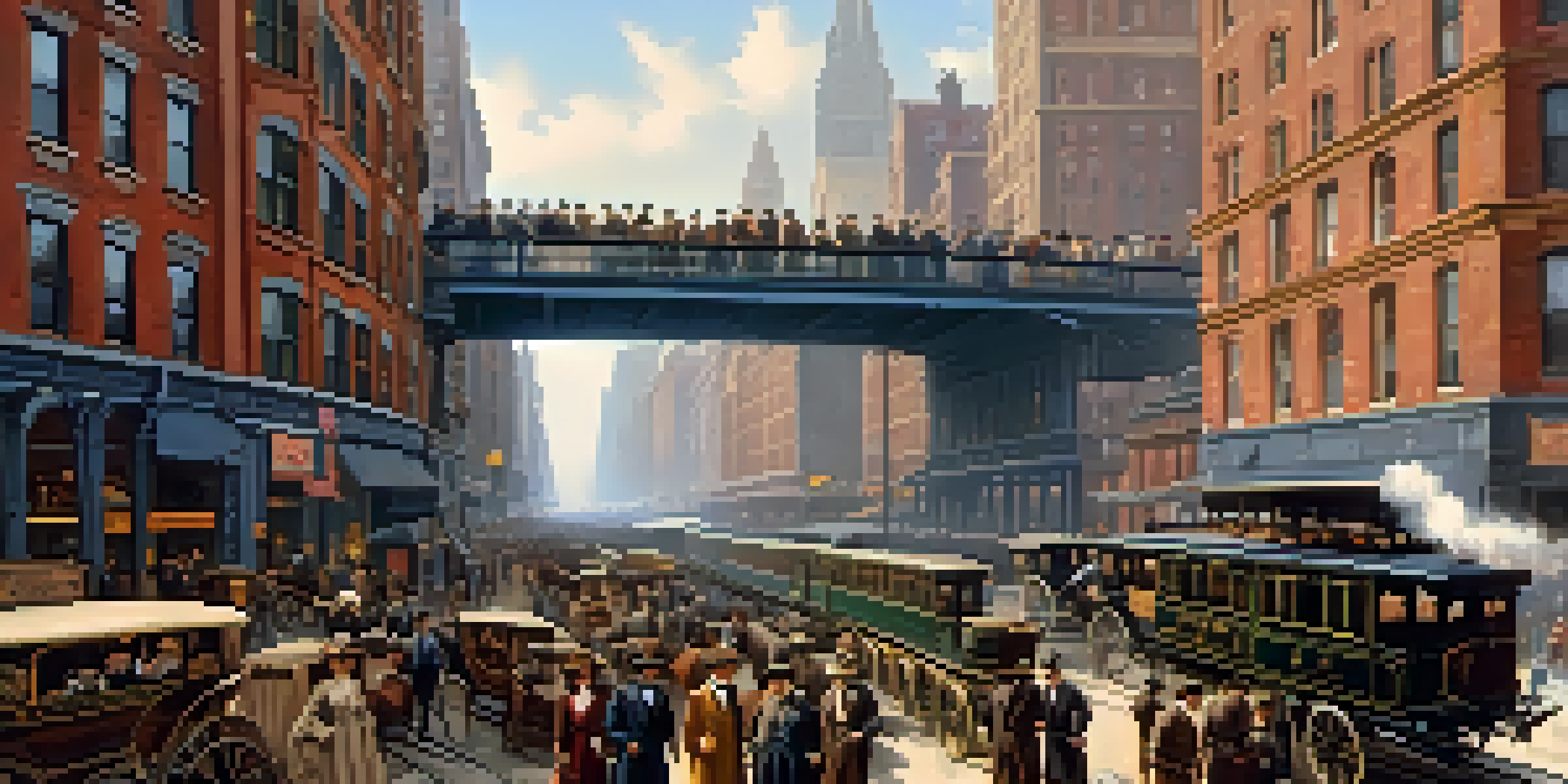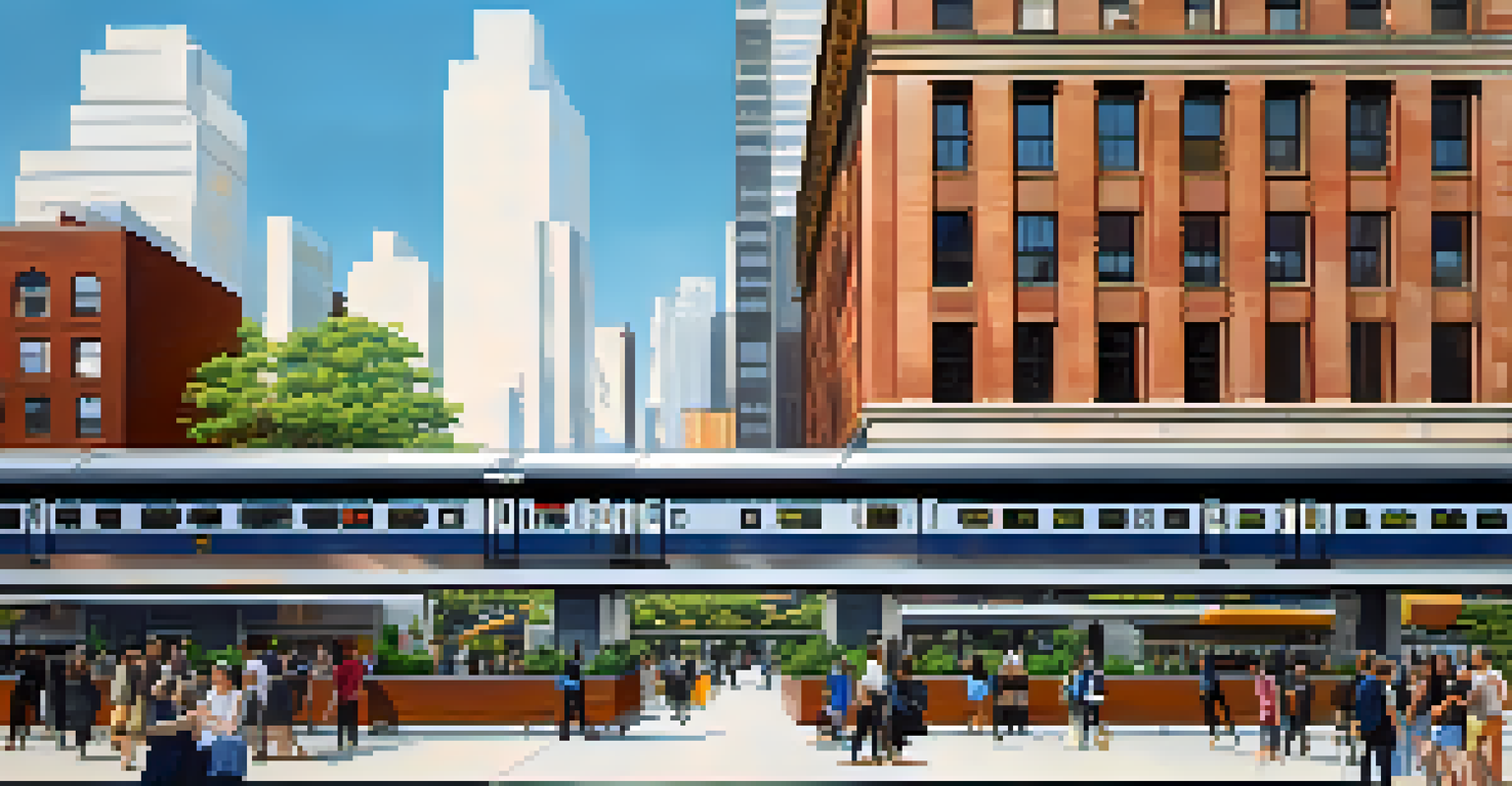The Introduction of the Elevated Train in New York City

A New Era Begins: The Birth of the Elevated Train
In the late 19th century, New York City faced a pressing issue: congestion. As the population swelled, so did the number of horse-drawn carriages and streetcars, creating a chaotic urban environment. To address this challenge, innovators turned their eyes upward, leading to the introduction of the elevated train, or 'el' as it’s affectionately known.
The elevated train is a symbol of New York City’s hustle and bustle, embodying the spirit of a city that never sleeps.
The first elevated train line opened in 1868, running from Battery Park to 27th Street. This groundbreaking project was a game-changer, allowing for faster and more efficient transportation. Suddenly, New Yorkers could travel above the crowded streets, marking a significant shift in urban mobility.
The elevated train not only provided a solution to the congestion problem but also set the stage for future expansions. With its unique design and innovative engineering, it laid the groundwork for what would become a comprehensive transit system, forever changing the landscape of the city.
Designing a Skyward Solution: Engineering Marvels
The design of the elevated train was as revolutionary as its concept. Engineers faced the challenge of ensuring safety while maximizing efficiency and speed. To achieve this, they developed sturdy iron structures that could withstand the test of time and the weight of countless passengers.

One of the most iconic examples is the Manhattan Railway, which featured a series of intricate bridges and viaducts. These elevated tracks not only provided a smooth ride but also offered breathtaking views of the bustling city below. Commuters often found themselves mesmerized by the sights, turning their daily commute into a scenic experience.
Elevated Train Transformed Transit
The introduction of the elevated train revolutionized urban mobility in New York City, providing a faster and more efficient transportation solution.
As the elevated train system grew, so did the complexity of its design. Innovations such as multiple tracks and signal systems were introduced, allowing for better management of train schedules. This evolution made it possible for the system to accommodate increasing ridership, solidifying its role in the city’s transit network.
Connecting Communities: The Social Impact
The introduction of the elevated train was about more than just transportation; it connected neighborhoods and communities like never before. Areas that were once considered remote became easily accessible, fostering economic growth and urban development. This newfound connectivity transformed the social fabric of the city.
Transportation is a means of connecting people and communities, shaping the way we interact with our urban environment.
For example, neighborhoods such as Harlem and the Lower East Side saw a surge in population and business opportunities. The elevated train made it possible for people to work in Manhattan while living in more affordable areas, thus reshaping demographics and cultural landscapes. This shift contributed to the rich tapestry of New York City.
However, this connection also had its downsides. Gentrification became a growing concern as rising property values pushed out long-time residents. The elevated train, while a symbol of progress, also highlighted the complexities of urban development and the challenges of balancing growth with community preservation.
Challenges on the Tracks: Safety Concerns
With innovation came challenges, particularly regarding safety. The elevated train system faced numerous incidents, from accidents to structural failures. In the early days, trains were operated manually, leading to occasional collisions and derailments, raising concerns among commuters.
In response, city officials implemented stricter safety regulations and invested in technological advancements. Automatic signals and improved braking systems were introduced, significantly reducing the risk of accidents. These measures helped restore public confidence in the elevated train system, allowing it to flourish.
Cultural Impact and Community Change
Beyond transportation, the elevated train connected neighborhoods, spurred economic growth, and reshaped the city's social fabric.
Despite these efforts, safety concerns lingered throughout the elevated train's history. Over the years, the system underwent several renovations to address structural integrity and meet modern safety standards, ensuring that it could continue to serve the ever-growing population of New York City.
Cultural Icon: The Elevated Train in Art and Media
The elevated train quickly became more than just a mode of transport; it turned into a cultural icon. Artists, writers, and filmmakers have captured its essence, showcasing the elevated train as a symbol of New York City’s hustle and bustle. Its unique appearance and character have made it a beloved subject in various forms of media.
From Edward Hopper's evocative paintings to classic films featuring sweeping shots of the elevated tracks, the train has been central to the narrative of urban life. It represents not just a means of getting from point A to point B, but the heartbeat of a city that never sleeps.
The elevated train's presence in pop culture has solidified its status as an enduring symbol of New York. It embodies the spirit of the city—dynamic, ever-evolving, and full of stories waiting to be told. This connection to culture has helped preserve its legacy, reminding everyone of its vital role in the city's history.
Modernization: The Future of Elevated Transit
As technology advances, so does the elevated train system. In recent years, there has been a push to modernize the infrastructure, introducing features like real-time tracking and improved passenger amenities. These updates aim to enhance the commuting experience while preserving the charm of the original design.
With the rise of eco-consciousness, there’s also a focus on sustainability. New York City is exploring ways to integrate renewable energy sources into its transit systems, including the elevated trains. This initiative not only addresses environmental concerns but also positions the city as a leader in modern urban transit solutions.
Ongoing Modernization and Safety
As technology advances, the elevated train system is being modernized to enhance safety and sustainability for future generations.
The future of the elevated train looks bright, with ongoing discussions about potential expansions and upgrades. As the city continues to grow, the elevated train will remain a vital component of its transportation network, adapting to meet the needs of New Yorkers for generations to come.
Conclusion: The Lasting Legacy of the Elevated Train
The elevated train has left an indelible mark on New York City’s history and development. From its humble beginnings as a solution to congestion to its role as a cultural icon, the elevated train has shaped the way New Yorkers live and interact with their city. It is a testament to the ingenuity and resilience of urban planning.
As we look back on its journey, it's clear that the elevated train was not just about transportation; it was about connecting people and communities. Its impact is felt in the vibrant neighborhoods it serves and the countless stories of everyday life that unfold on its tracks.

In celebrating the elevated train, we acknowledge its significance in the broader narrative of New York City. It serves as a reminder of how innovation can transform a city, and how, even in the face of challenges, progress can pave the way for a brighter future.